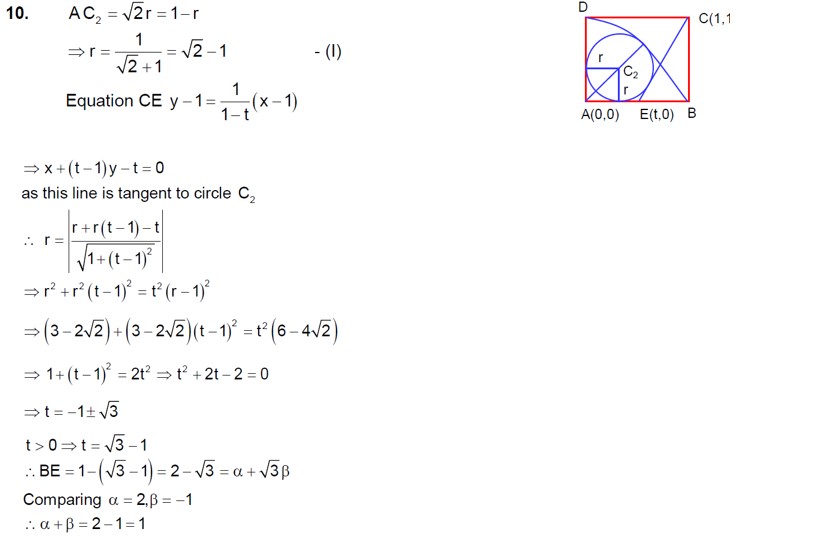Ncert Solutions Maths class 11th
Get insights from 1.6k questions on Ncert Solutions Maths class 11th, answered by students, alumni, and experts. You may also ask and answer any question you like about Ncert Solutions Maths class 11th
Follow Ask QuestionQuestions
Discussions
Active Users
Followers
New answer posted
2 months agoContributor-Level 10
2x + y = 4
2x + 6y = 14
} y=2, x=3
B (1, 2)
Let C (k, 4–2k)
Now AB² = AC²
=> 5k² – 24k + 19 = 0
α = (6+1+10/5)/3 = 18/5
Now 15 (α+β)
15 (17/5) = 51
New answer posted
2 months agoContributor-Level 10
f (x) = x? – 4x + 1 = 0
f' (x) = 4x³ – 4
= 4 (x–1) (x²+1+x)
=> Two solution
New answer posted
2 months agoContributor-Level 10
dy/dx = (ax-by+a)/ (bx+cy+a)
=> bxdy + cydy + ady = axdx – bydx + adx
cy²/2 + ay – ax²/2 – ax + bxy = k
ax² + ay² + 2ax – 2ay = k
=> x² + y² + 2x – 2y = λ
Short distance of (11,6)
= √12²+5² – 5
= 13 – 5
= 8
New answer posted
2 months agoContributor-Level 10
x = Σ a? = 1/ (1-a); y = Σ b? = 1/ (1-b); z = Σ c? = 1/ (1-c)
Now,
a, b, c → AP
1-a, 1-b, 1-c → AP
1/ (1-a), 1/ (1-b), 1/ (1-c) → HP
x, y, z → HP
New answer posted
2 months agoContributor-Level 10
z? = iz²
Let z = x + iy
x – iy = I (x² – y² + 2xiy)
Case-I
x = 0
–y² = –y
y = 0, 1
Case - II
y = – 1/2
=> x² – 1/4 = 1/2 => x = ±√3/2
Area of polygon
= 1/2 | (0, 1, 1), (√3/2, -1/2, 1), (-√3/2, -1/2, 1) |
= 1/2 | -√3/2 - √3/2 | = 3√3/4
New answer posted
2 months agoContributor-Level 9
lim (x→0) [a e? - b cos (x) + c e? ] / (x sin (x) = 2
Using Taylor expansions around x=0:
lim (x→0) [a (1+x+x²/2!+.) - b (1-x²/2!+.) + c (1-x+x²/2!+.)] / (x * x) = 2
lim (x→0) [ (a-b+c) + x (a-c) + x² (a/2+b/2+c/2) + O (x³)] / x² = 2
For the limit to exist, the coefficients of lower powers of x in the numerator must be zero.
a - b + c = 0
a - c = 0 ⇒ a = c
Substituting a=c into the first equation: 2a - b = 0 ⇒ b = 2a.
The limit becomes: lim (x→0) [x² (a/2 + b/2 + c/2)] / x² = (a+b+c)/2
(a + b + c) / 2 = 2 ⇒ a + b + c = 4.
New answer posted
2 months agoContributor-Level 9
|z+i|/|z-3i| = 1 ⇒ |z+i| = |z-3i|. This means z is on the perpendicular bisector of the segment from -i to 3i. The midpoint is i, so z = x+i.
w = z? - 2z + 2. Let z = x + iy.
w = (x² + y²) - 2 (x + iy) + 2 = (x² - 2x + 2 + y²) - 2iy.
Re (w) = x² - 2x + 2 + y² = (x - 1)² + 1 + y².
From the first condition, y=1. Re (w) = (x - 1)² + 1 + 1 = (x - 1)² + 2.
Re (w) is minimum for x = 1.
The common z is z = 1 + i.
w = (1+i) (1-i) - 2 (1+i) + 2 = 2 - 2 - 2i + 2 = 2 - 2i.
w² = (2 - 2i)² = 4 (1 - 2i - 1) = -8i.
w? = (-8i)² = -64 ∈ R.
∴ least n ∈ N for which w? ∈ R is n=4.
New answer posted
2 months agoContributor-Level 10
Let t = 3^ (x/2). As x→2, t→3^ (2/2) = 3.
The limit becomes lim (t→3) [ (t² + 27/t²) - 12 ] / [ (t - 3²/t) ].
lim (t→3) [ (t? - 12t² + 27)/t² ] / [ (t² - 9)/t ].
lim (t→3) [ (t²-9) (t²-3) / t² ] * [ t / (t²-9) ].
lim (t→3) [ (t²-3) / t ].
Substituting t=3: (3²-3)/3 = (9-3)/3 = 6.
(The provided solution arrives at 36, let's re-check the problem statement)
The denominator is t - 9/t, not t - 3²/t.
lim (t→3) [ (t²-9) (t²-3) / t² ] * [ t / (t-3) (t+3)/t ]
This leads to the same cancellation. Let's re-examine the image's steps.
lim (t-3) (t³ - 27)/ (t-3) . The algebra in the image is hard to follow but seems to manipul
New question posted
2 months agoTaking an Exam? Selecting a College?
Get authentic answers from experts, students and alumni that you won't find anywhere else
Sign Up on ShikshaOn Shiksha, get access to
- 65k Colleges
- 1.2k Exams
- 679k Reviews
- 1800k Answers

